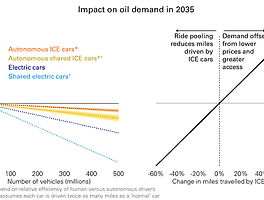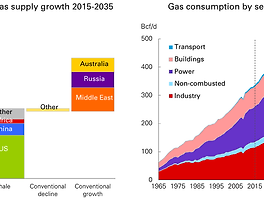bp-energy-outlook-2017 보고서에는 2016년 보고서대비 수정되어야 하는 사항도 언급되어 있어 보고서의 신뢰를 높이고 있습니다.
Energy demand in 2035 has been revised down with a further shift in the fuel mix towards renewables
Chinese energy demand has been revised down offset by stronger growth in other parts of emerging Asia
• The largest downward revision is to coal (-6%, -240 Mtoe), where there is increasing evidence that a rebalancing of economic growth within China together with tightening climate and environmental policies are likely to lead to a plateauing in
China’s coal consumption over the Outlook.
• Renewables have been revised up 15% (220 Mtoe) - the largest revision in percentage terms - as the prospective path for costs continues to surprise on the downside. As a result, the use of both coal and gas in the power sector has been revised down, with gas consumption in total down 2.5% (-110 Mtoe) by 2035.
• The upward revision in the share of non-fossil fuels relative to fossil fuels has led to an improvement in the expected carbon intensity of the fuel mix, contributing to a sizeable downward revision in the level of carbon emissions by 2035 (-3.7%, -1.4 billion tonnes of CO 2 on a like-for-like basis).
• 2035 년의 에너지 수요는 2016 년 전망 대비 거의 1 % (-150Mtoe) 하향 조정되었습니다. 이는 지난 해와 비슷한 규모의 개정이지만, 역사적 수정과 관련하여 큰 편입니다. 하향 조정은 2035 년 GDP가 1 년 전에 비해 2 % 감소 할 것으로 예상되는 약한 경제 전망을 반영합니다.
• 가장 큰 하향 조정은 석탄 (-6 %, -240 Mtoe)에 대한 것이며, 기후 및 환경 정책 강화와 함께 중국 내 경제 성장의 재조정이 고비용으로 이어질 가능성이 높아지고있다.
중국의 석탄 소비 전망.
• Renewables는 15 % (220 Mtoe)까지 수정되었는데, 이는 비용 측면에서 가장 큰 수정이며 비용의 예상 경로가 계속해서 부정적으로 계속 놀랄 수 있습니다. 결과적으로, 2035 년까지 총 가스 소비량은 2.5 % (-110Mtoe) 감소하면서 전력 부문에서 석탄과 가스 모두 사용량이 줄었습니다.
• 화석 연료와 관련한 비 화석 연료 비중의 상향 조정으로 인해 연료 혼합물의 예상 탄소 강도가 향상되어 2035 년까지 탄소 배출량을 상당 수준 하향 조정 (-3.7 %, 같은 목적으로 14 억 톤의 이산화탄소 배출).
Chinese energy demand has been revised down offset by stronger growth in other parts of emerging Asia
Renewables in US and EU power mix have been revised up but offsetting revisions to gas and coal differ markedly
• Around half of that difference reflects lower-than-expected outturns for energy consumption in recent years, as economic growth has slowed more quickly than expected and energy intensity has fallen more sharply. The remainder reflects weaker prospects for economic growth, particularly in the second half of the Outlook.
• Despite this large downgrade to Chinese consumption, the expected level of energy demand in emerging Asia as a whole in 2035 is broadly unchanged: upward revisions to energy consumption in India and other emerging Asia economies offset the reductions to Chinese demand.
• These upward revisions to Asian energy demand outside of China reflect a moreupbeat view of economic growth, partly reflecting the expectation that as China’s economy matures and rebalances, some industries will migrate to cheaper, lowerincome Asian economies, such as India, Indonesia or Vietnam.
• 중국의 에너지 수요 전망은 지난 3 년간 현저히 낮아졌다. 2035 년 중국의 에너지 소비 전망은 2014 년 8 % (400Mtoe)를 밑도는 수준이다.
• 그 차이의 약 절반은 경제 성장이 예상보다 더 빨리 둔화되고 에너지 집약도가 급격히 떨어짐에 따라 최근 몇 년 동안 예상보다 낮은 에너지 소비에 대한 예상치를 반영합니다. 나머지는 특히 전망의 후반부에 경제 성장에 대한 약한 전망을 반영합니다.
• 중국 소비가 크게 위축 되었음에도 불구하고, 2035 년에 신흥 아시아 전체의 에너지 수요 예상치는 크게 변하지 않았습니다. 인도 및 기타 아시아 이머징 국가의 에너지 소비량 상향 조정은 중국 수요 감소를 상쇄합니다.
• 중국 이외의 아시아 에너지 수요의 이러한 상향 조정은 중국 경제가 성숙되고 균형을 맞춰 감에 따라 일부 산업이 인도, 인도네시아 또는 베트남과 같이 저렴하고 저평가 된 아시아 경제로 이전 할 것이라는 기대를 부분적으로 반영하여 경제 성장에 대한보다 견실 한 전망을 반영합니다.
Renewables in US and EU power mix have been revised up but offsetting revisions to gas and coal differ markedly
• The expected share of renewables in both the US and EU power sectors has been revised up significantly since 2011: up 8 percentage points (pp) in the US and 9 pp in the EU by 2030. But the associated revisions to the shares of coal and gas in the two power sectors differ quite markedly.
• In the US, the unexpected strength of the shale gas revolution since 2011 has also led to a significant upward revision to the expected share of natural gas (7 pp). The main casualty is coal, crowded out by the greater-than-expected competitiveness of both renewables and gas, such that its share has been revised down 14 pp.
• In contrast, the upward revision to the share of renewables in the EU power sector has been offset by broadly similar downward revisions to the shares of natural gas (-6 pp) and coal (-5 pp).
• Absent a significant increase in the availability of gas in the EU, to achieve a similar pattern of revisions to the US would require stronger-than-expected policy support for gas relative to coal.
• 미국과 EU의 전력 부문에서 재생 가능 에너지의 예상되는 비율은 2011 년 이후 크게 상향 조정되었다 : 2030 년까지 미국의 경우 8 % p, EU의 경우 9pps 증가한다. 그러나 석탄의 공유에 대한 개정 두 전력 부문의 가스는 상당히 뚜렷하게 다르다.
• 미국의 2011 년 이후 셰일 가스 혁명의 예기치 못한 힘은 예상되는 천연 가스 점유율 (7 pp)을 크게 상향 조정했습니다. 주된 사상자는 석탄으로, 재생 에너지와 가스 모두의 예상보다 큰 경쟁력으로 인해 혼잡 해져서 그 점유율이 14 pp.
• 반면 EU 에너지 부문의 재생 에너지 점유율에 대한 상향 조정은 천연 가스 (-6pp)와 석탄 (-5pp)에 대한 유사한 하향 조정으로 상쇄되었습니다.
• 유럽 연합의 가스 가용성의 현저한 증가가 없다면 비슷한 수정 패턴을 달성하기 위해서는 석탄에 비해 가스에 대한 기대 이상의 정책 지원이 필요하다.
[재테크] - BP 2017 에너지전망(+ Welcome to the 2017 edition of BP’s Energy Outlook)
[재테크] - BP 2017 에너지전망(+ Base case: Primary energy)
[재테크] - BP 2017 에너지전망(+ oil fuel by fuel detail)
[재테크] - BP 2017 에너지전망(+ Natural gas fuel by fuel detail)
[재테크] - BP 2017 에너지전망(+ key issue)
[재테크] - BP 2017 에너지전망(+ Main revision)
[재테크] - BP 2017 에너지전망(+ Key uncertainties)
[재테크] - BP 2017 에너지전망(+ Beyond 2035)
[재테크] - BP 2017 에너지전망(+ Annex)
'Energy' 카테고리의 다른 글
| BP 2017 에너지전망(+ Beyond 2035) (0) | 2018.02.09 |
|---|---|
| BP 2017 에너지전망(+ Key uncertainties) (0) | 2018.02.08 |
| BP 2017 에너지전망(+ key issue) (0) | 2018.02.06 |
| BP 2017 에너지전망(+ Natural gas fuel by fuel detail) (0) | 2018.02.05 |
| BP 2017 에너지전망(+ Coal, Nuclear and hydro, Renewables) (0) | 2018.02.04 |






